New Mexico lies in the Southwestern United States. It is the fifth-largest state in the nation by total area. Here is a look at the size of this state, known as the “Land of Enchantment,” as well as how it compares with the areas of other U.S. states and more.
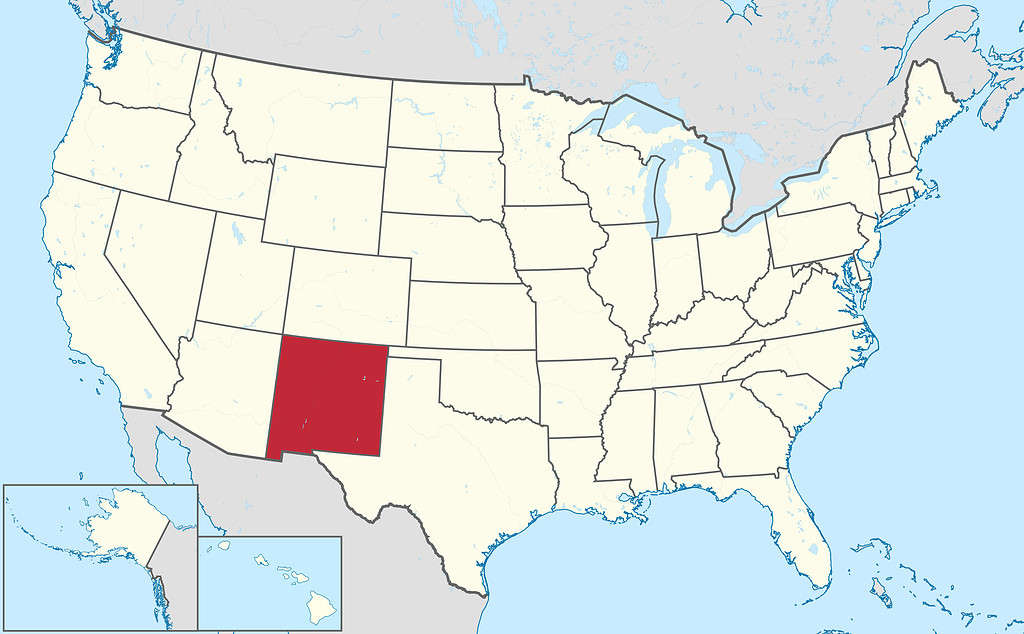
Located in the U.S. Southwest, New Mexico is among the top five largest states in the nation.
©TUBS / CC BY-SA 3.0 – License
Length and Width of New Mexico
New Mexico stretches 371 miles (596 kilometers) from north to south, except for the far western section of the state. In extreme southwestern New Mexico, the border drops further south than the rest of the state. The area is known as the Bootheel. The north-to-south measurement of far western New Mexico is 390 miles (628 kilometers). This is the same north-to-south measurement as neighboring Arizona.
New Mexico’s east-to-west measurement is 344 miles (552 kilometers). It is only slightly wider than Arizona, which measures 335 miles from east to west.
The Bootheel marks the narrowest east-to-west point of the state, measuring only 50 miles (80 kilometers) wide.
Square Miles and Kilometers
New Mexico’s total area spans 121,598 square miles or 314,937 square kilometers. Approximately 235 square miles (609 square kilometers) of the state’s area is covered by water, giving the Land of Enchantment around 121,365 square miles (314,334 square kilometers) of land area.
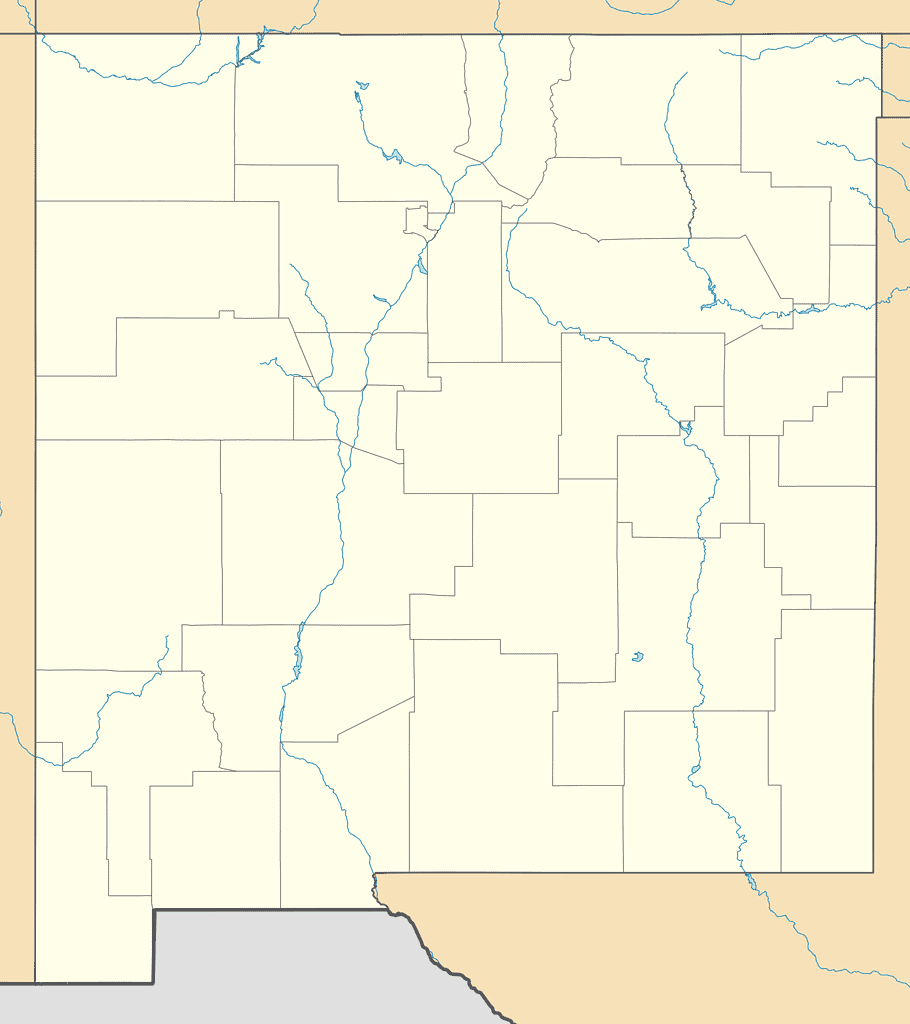
New Mexico covers a vast expanse of 121,598 square miles.
©Alexrk2 / CC BY 3.0 – License
Acres
An acre is roughly equivalent to the size of a football field (excluding the end zones). There are 640 acres in a square mile. New Mexico’s territory covers 77,822,720 acres.
Other States
As noted earlier, New Mexico is the fifth-largest state in the U.S. The closest state in terms of total size is New Mexico’s neighbor to the west. Arizona’s total area is about 7,600 square miles less than that of New Mexico.
Alaska is the largest state in the U.S. by a wide margin. At 665,384 square miles (1,723,337 square kilometers), Alaska is nearly five times the size of New Mexico.

If Alaska were placed over the conterminous United States, it would touch both the Atlantic and Pacific coasts.
©DrRandomFactor / CC BY-SA 3.0 – License
Texas, New Mexico’s neighbor to the east, is about 2.2 times larger than New Mexico. California outsizes New Mexico by over 42,000 square miles, and Montana is over 25,000 square miles larger than New Mexico.
Rhode Island is the smallest U.S. state. You could fit over 100 Rhode Islands inside New Mexico’s borders! In fact, the smallest ten U.S. states could fit inside New Mexico. If West Virginia, Maryland, Hawaii, Massachusetts, Vermont, New Hampshire, New Jersey, Connecticut, Delaware, and Rhode Island were placed inside of New Mexico, there would still be over 26,500 square miles of space left over. That is enough room for an additional West Virginia or nearly 22 more Rhode Islands!
New Mexico accounts for about 3.2% of the total area of the U.S. Only six states contain three percent or more of the United States’ total area. Along with New Mexico, those states include Arizona (3%), Montana (3.87%), California (4.31%), Texas (7.07%), and Alaska (17.48%).
Land Regions
New Mexico’s 121,598 square miles are divided into four land regions: the Great Plains, the Colorado Plateau, the Rocky Mountains, and the Basin and Range region.
- The Great Plains covers the eastern third of New Mexico, running from a high plateau in northern New Mexico south to the Pecos River.
- The Colorado Plateau lies in the state’s northwest and consists of rugged cliffs, canyons, valleys, and mesas.
- North-central New Mexico is covered by mountain ranges that are part of the Rocky Mountains.
- The Basin and Range Region covers about one-third of the state south of the Rocky Mountain region. The area features mountain ranges such as the Guadalupe, Mogollon, Organ, Sacramento, and San Andres mountain ranges. These ranges are separated by desert basins, hence the name of the land region.
State and International Borders
New Mexico shares borders with Colorado to the north, Oklahoma to the east, Texas to the east and south, Mexico to the south, and Arizona to the west.
The international border between New Mexico and the nation of Mexico stretches for 180 miles. It accounts for about nine percent of the total U.S.-Mexico border.
The northwestern point of New Mexico is part of the Four Corners region. This point lies at 36.999° north latitude and 109.045° west longitude and marks the only place in the nation where four states meet. The northwestern corner of New Mexico, the northeastern corner of Arizona, the southeastern corner of Utah, and the southwestern corner of Colorado all come together at this junction. Most of the Four Corners region belongs to Native American tribes, the largest of which is the Navajo Nation.

New Mexico borders four U.S. states and the nation of Mexico.
©Thinkstock/Stockbyte via Getty Images
Elevation
New Mexico has the fourth-highest mean elevation in the United States at 5,700 feet (1,737 meters). The only states with higher mean elevations are Colorado (6,800 feet), Wyoming (6,700 feet), and Utah (6,100 feet). Nevada and Idaho trail just behind New Mexico with mean elevations of 5,500 feet and 5,000 feet, respectively.
Wheeler Peak in the Sangre de Cristo mountain range is the highest point in New Mexico at 13,161 feet above sea level. Red Bluff Reservoir is the lowest point in New Mexico at 2,842 feet above sea level.
Delaware has the lowest mean elevation of any U.S. state at just 60 feet above sea level, followed by Florida and Louisiana, which both have mean elevations of 100 feet.
Population
New Mexico is the fifth-largest state by area, but it is in the bottom third of U.S. states in terms of population. The U.S. Census Bureau estimated 2,113,344 residents called New Mexico home in 2022. The state’s populace is just slightly larger than that of Nebraska, which had an estimated 2022 population of 1,967,923.
Wyoming is the least populous state in the nation, with a 2022 population of 581,381. New Mexico’s population is more than three and a half times that of Wyoming.
California is the most populous U.S. state, with a 2022 estimated 39,029,342 residents. California’s population is nearly 18.5 times larger than New Mexico’s.
New Mexico’s vast area and its relatively small population give the state one of the lowest population densities in the nation. Population density is calculated by the number of people per square mile of land area. New Mexico has a population density of 17.5 people per square mile, making it the sixth least densely populated state in the U.S. Only South Dakota, North Dakota, Montana, Wyoming, and Alaska have lower population densities. Alaska has a scant 1.3 people per square mile, the lowest population density in the U.S.
New Jersey is the most densely populated state in the nation, with 1,263 people per square mile. The most densely populated place anywhere in the United States is Washington, D.C., with a whopping 11,295 people per square mile.

New Mexico is an expansive state, but large swaths of its territory are sparsely populated.
©© Getty Images/Photodisc via Getty Images
Largest Cities
New Mexico has three cities with over 100,000 residents. Albuquerque is the state’s largest city by far, with a 2022 population estimate of 561,008. The greater metro area around Albuquerque is home to nearly 916,000 residents. Over 43% of New Mexicans live in the Albuquerque metropolitan area.
The other New Mexico cities with populations north of 100,000 are Las Cruces (113,888) and Rio Rancho (108,082).
Santa Fe is the capital of New Mexico and the state’s fourth-largest city, with just over 89,000 residents. It is also the oldest state capital in the United States. Santa Fe was founded in 1610 and became the capital of the province of Santa Fe de Nuevo México, part of the Spanish-ruled territory known as New Spain.
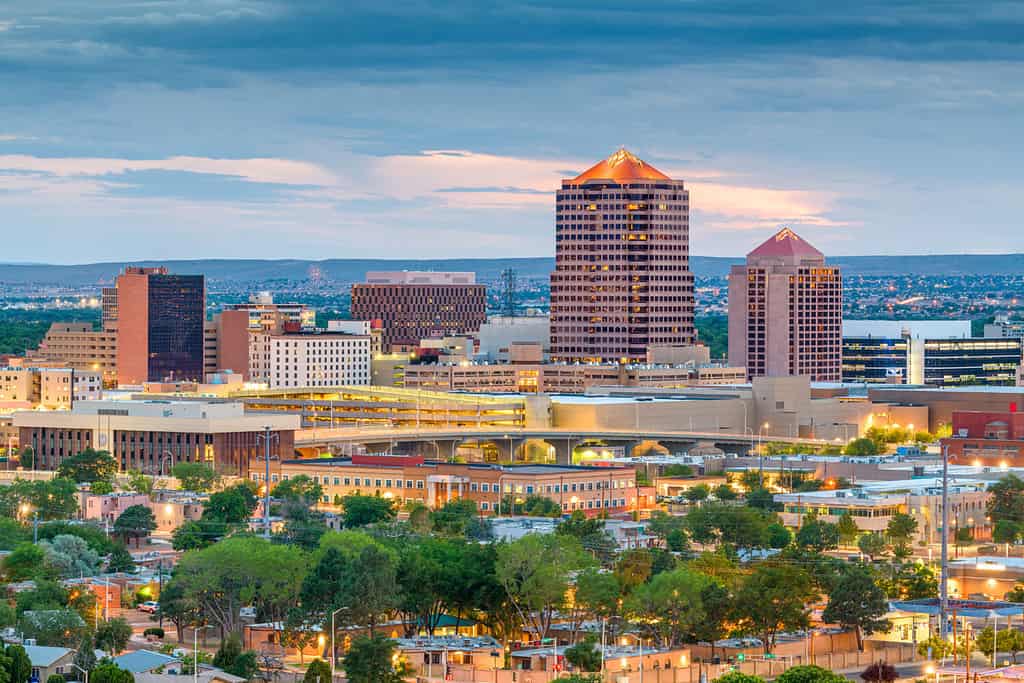
Over 900,000 people live in Albuquerque and the surrounding metro area.
©Sean Pavone/Shutterstock.com
Counties
There are 33 counties in New Mexico, significantly less than the number of counties in the average U.S. state (62). That means most of the counties in this expansive state are quite large.
The biggest county by area is Catron County in western New Mexico. This county spans 6,928 square miles (17,943 square kilometers). Catron County is bigger than three U.S. states (Connecticut, Delaware, and Rhode Island).
Los Alamos County is the smallest county in the state, which covers a mere 109 square miles (282 kilometers). It is the only county in New Mexico with a territory of less than 1,000 square miles. Los Alamos County was formed out of parts of Santa Fe and Sandoval counties in 1949. It was a key location for the Manhattan Project. J. Robert Oppenheimer was the director of the Los Alamos Laboratory during World War II.
New Mexico’s most populous county is Bernalillo County which houses the state’s largest city of Albuquerque. The county spans 1,166 square miles (3,020 square kilometers) and is home to 672,508 residents.
The least populous county in the state is Harding County. Though the county covers 2,126 square miles (5,506 kilometers), it is only home to 628 residents. In terms of population, it is the thirteenth smallest county in the nation.
Parks and More
New Mexico houses two national parks.
Carlsbad Caverns National Park is located in southeastern New Mexico, just a few miles north of the Texas border. The park is named for Carlsbad Cavern, the second-largest of the park’s 120 known caves. Carlsbad Cavern features a large limestone chamber known as the Big Room. It spans 8.2 acres, making it the largest chamber in North America and the 32nd largest in the world. The entire park covers 46,766 acres, including over 33,000 acres of designated wilderness. There are 67 mammal species documented in the park, including 17 bat species.
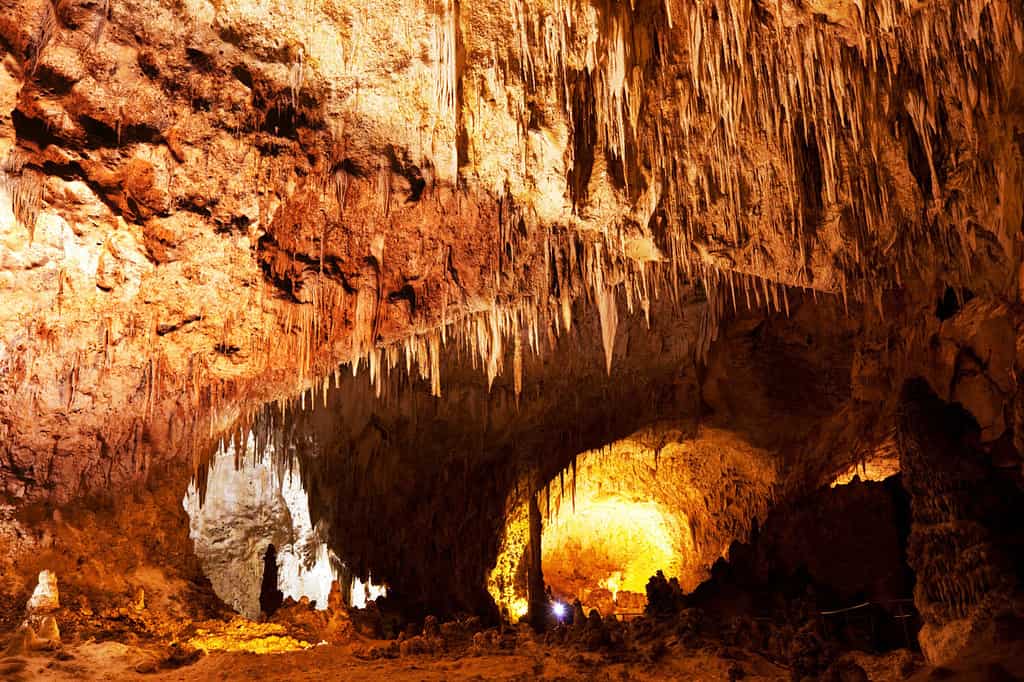
Carlsbad Caverns was established as a national park in 1930.
©Galyna Andrushko/Shutterstock.com
White Sands National Park spans 145,762 acres in the south-central New Mexican desert. The park contains the world’s largest gypsum sand dune field. The dune field is 30 feet deep and features dunes as tall as 60 feet. About 4.5 billion short tons of gypsum sand are found here. President Herbert Hoover designated the area as a national monument in 1933. It was reclassified as a national park in 2019, signed into law by President Donald Trump. The park is completely surrounded by the White Sands Missile Range and is occasionally closed due to missile tests.
Along with the two national parks, New Mexico is also home to many other federally-managed public lands, including the Aztec Ruins National Monument, Bandelier National Monument, Capulin Volcano National Monument, Chaco Culture National Historic Park, El Malpais National Monument, El Morro National Monument, Fort Union National Monument, Gila Cliff Dwellings National Monument, Manhattan Project National Historic Park, Pecos National Historic Park, Petroglyph National Monument, Salinas Pueblo Missions National Monument, and Valles Caldera National Preserve.
State Animals
New Mexico has designated eight official state animals. The American black bear was named the state mammal in 1963.
New Mexico’s other state animals include the New Mexico spadefoot toad (state amphibian), greater roadrunner (state bird), Sandia hairstreak butterfly (state butterfly), Rio Grande cutthroat trout (state fish), Coelophysis (state fossil), tarantula hawk wasp (state insect), and New Mexico whiptail lizard (state reptile).
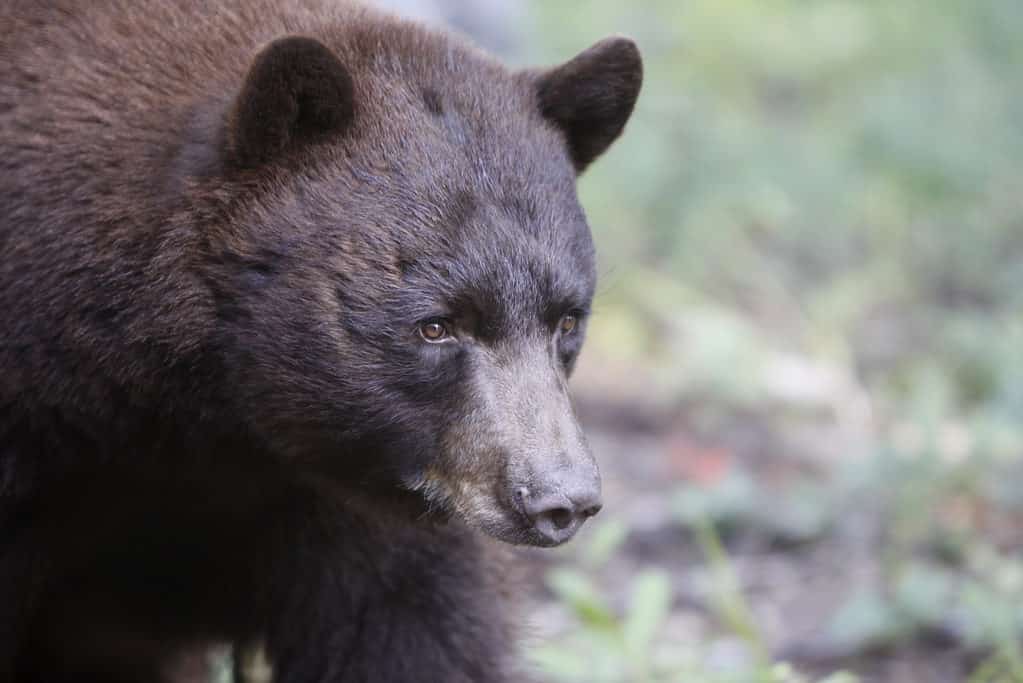
The American black bear is the state mammal of New Mexico. This individual was photographed n the mountains near Angel Fire, New Mexico.
©iStock.com/jjMiller11
The photo featured at the top of this post is © A-Z-Animals.com/
Thank you for reading! Have some feedback for us? Contact the AZ Animals editorial team.






